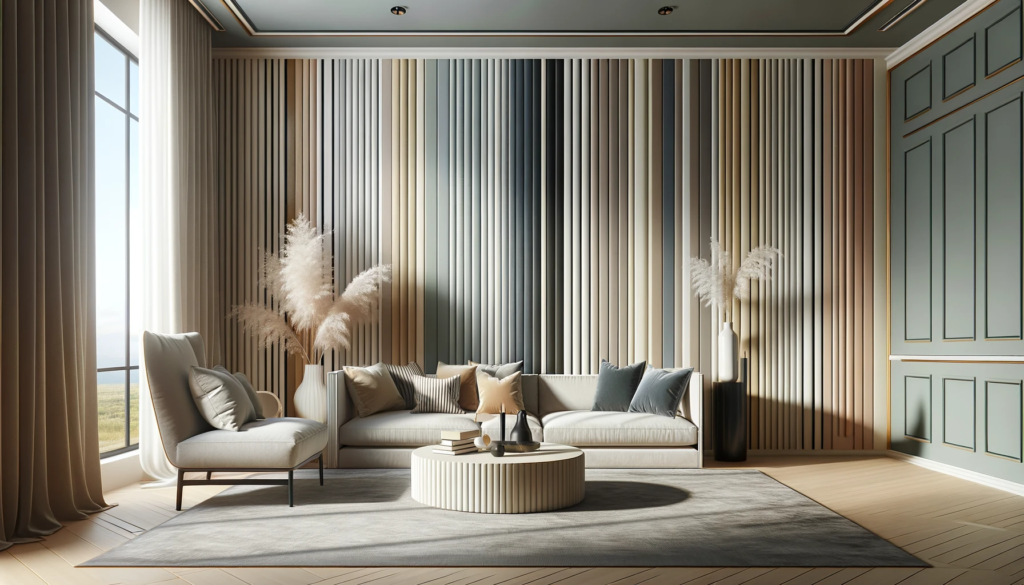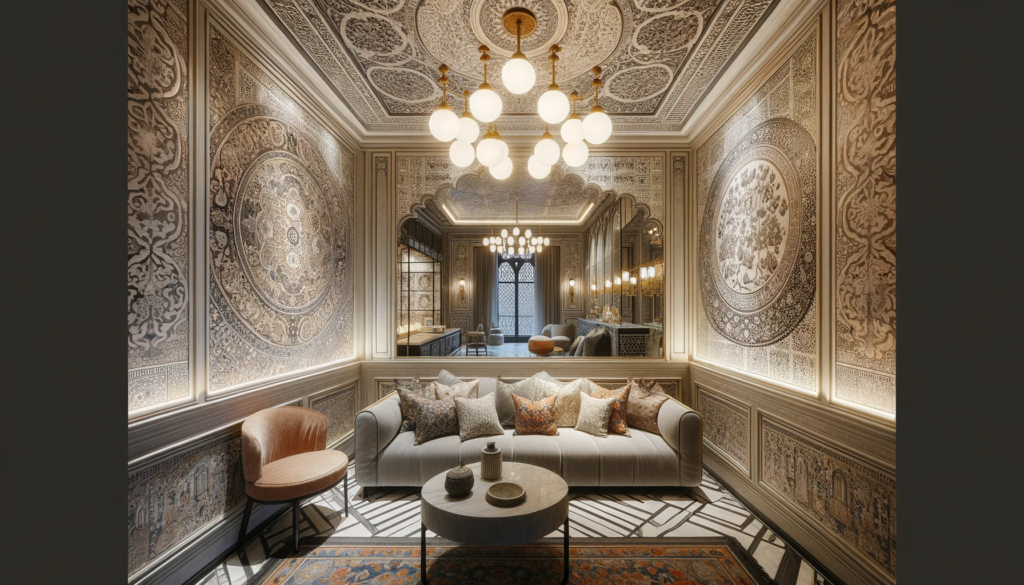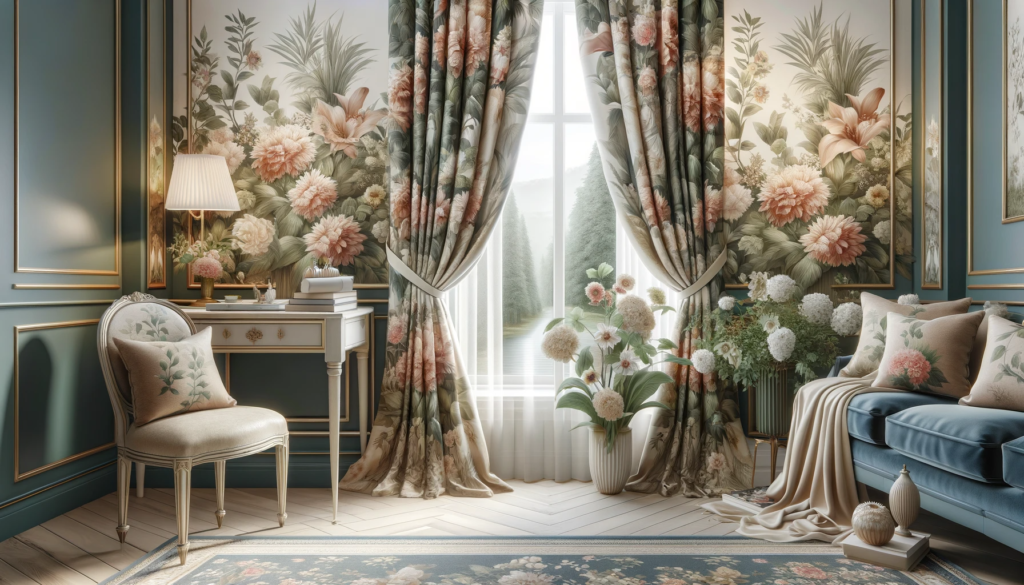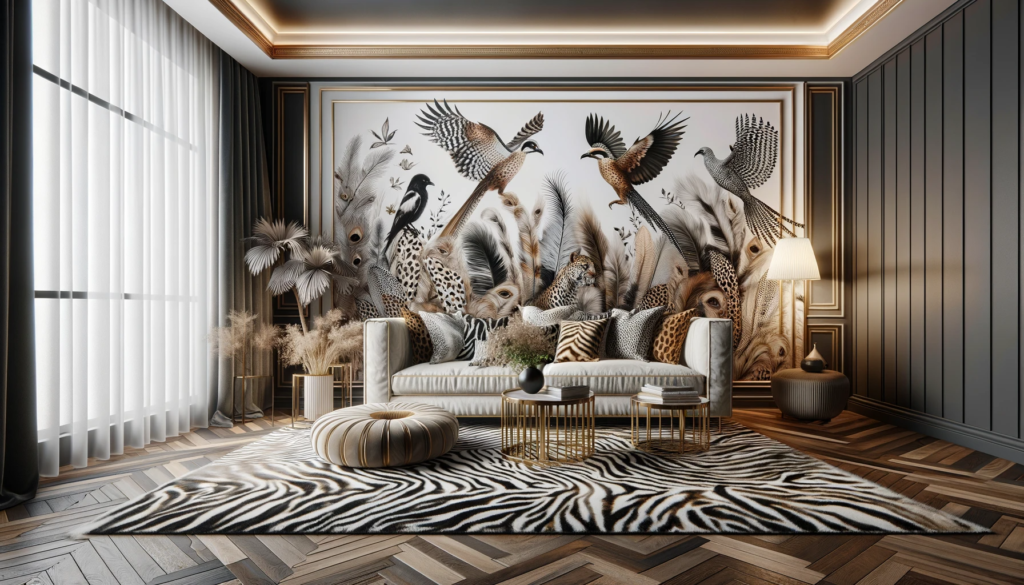In the dynamic world of interior design, patterns play an instrumental role in transforming spaces from mundane to magnificent. The art of pattern mixing is not just about the bold use of colors or the daring juxtaposition of motifs; it’s a nuanced approach to creating an ambiance that reflects a person’s taste, lifestyle, and the story they wish to tell through their space.
Whether you’re looking to refresh a single room or embark on a major redesign, the insights provided here will equip you with the knowledge to confidently use and mix patterns, creating spaces that are not only visually appealing but also deeply personal and unique.
Patterns in Interior Design
Design patterns aren’t just ornamental aspects; they’re the heartfelt storytellers of a room’s narrative. They infuse interiors with character, depth, and dimensions, shaping the ambiance and emotional tone. The strategic use of patterns can alter perceptions of space, making it appear more expansive, intimate, lively, or serene.
Within interior design’s domain, patterns have diverse roles. They highlight specific zones, blend different components, or establish a room’s focal point. For example, a living room can be anchored by a wall with bold patterns, or a subtly designed rug can harmonize a room’s color and texture palette.
Patterns also mirror the dwellers’ personality and taste. Some might favor the refined simplicity of stripes or geometric patterns’ subtle allure, while others may lean towards the dynamic impact of intricate or floral designs. Such versatility renders patterns a crucial element in a designer’s toolkit.
Moreover, patterns adeptly tackle unique design challenges. In dimly lit spaces, vibrant and lively patterns inject brightness and vitality. In expansive areas, patterns can segment space, effectively organizing different functions within an open-plan setting.
We’ll delve into the various pattern types in interior design in subsequent sections, examining how to effectively combine them to forge distinctive and attractive environments. From the timeless elegance of stripes to the detailed charm of motifs, each pattern type presents unique characteristics and opportunities for use in interior design.
Types of Patterns in Interior Design
Interior design patterns boast remarkable diversity, each providing its own visual narrative and aesthetic influence. This assortment enables both designers and homeowners to exhibit their creativity and establish the desired ambiance in any area. Grasping the nuances of different pattern types is key to well-informed design choices.
Ranging from the understated elegance of stripes to the intricate allure of motifs and the organic beauty of floral designs, each pattern type infuses a distinct essence and atmosphere into a space. In the upcoming sections, we’ll explore the specifics of various patterns, including stripes, complex designs, geometric shapes, florals, motifs, and animal-inspired patterns.
Each category possesses unique traits, appropriateness, and ways of being woven into interior settings. Through this exploration, we’ll gain insights into how patterns can be blended and juxtaposed effectively, crafting spaces that are visually appealing and pragmatically coherent.

Stripe Patterns
Stripes stand as a remarkably adaptable and enduring element in interior décor. Their range spans from the understated to the striking, and from traditional to contemporary, fitting seamlessly into diverse design contexts. A key feature of stripes is their influence on how a room’s dimensions and shape are perceived.
Especially notable are vertical lines, which can transform a room’s perceived proportions. They draw the gaze upward, making rooms seem taller and ceilings loftier, an excellent strategy for areas with lower ceilings. This effect of vertical stripes is further detailed in our exclusive article on our website, where we delve into their role in altering room dynamics and their effective application in various environments.
Stripes can be introduced in numerous ways, such as through wallpapers, textiles, carpets, or even architectural details. They are effective in both monochromatic styles and when paired with other patterns. The stripe’s width itself can significantly alter the overall effect, with finer stripes lending subtlety, while broader stripes convey a more pronounced statement.
When integrating stripes with other patterns, it’s crucial to keep scale and color schemes in mind to ensure a cohesive and harmonious design. Stripes can serve as a stabilizing factor in a mix of patterns, offering structured contrast to more fluid or intricate designs.
In essence, stripes are a dynamic component in interior styling, capable of creating visual illusions and introducing elegant rhythm into any space. Their classic charm and flexibility make them a consistently popular choice among designers and homeowners.

Motif Patterns
Motif designs in home decor stand out as specific, recurring elements that imbue spaces with depth, character, and a touch of cultural essence. These patterns range from straightforward repeated shapes to intricate, symbolic designs that often bear historical or cultural relevance. Motifs are frequently employed to introduce a particular theme to an area or to mirror the personal tastes or heritage of the residents.
The essence of motif patterns is their capacity to narrate a story or express an idea through design. These designs can originate from various sources, such as nature, art, historical periods, and different cultures. For instance, a motif with Greek key patterns might impart a sense of classical elegance, while an Art Deco motif could bring a dash of glamour and finesse.
Incorporating motif designs into an interior can vary in approach. They can be prominently displayed in wallpapers, tiling, or fabrics, or subtly integrated into minor decorative pieces like cushions, art, or carpets. The crucial factor is choosing motifs that align with the room’s overarching theme and aesthetic.
When amalgamating motif patterns with other pattern types, it’s vital to balance the visual prominence and intricacy of each design. Harmonizing a striking motif with more understated geometric or floral patterns can establish a visually satisfying equilibrium. Keeping a consistent color palette is also important to ensure the patterns complement rather than clash.
Motif patterns shine in spaces where creating a central point of interest or adding an extra layer of visual intrigue is desired. They can accentuate particular architectural features, demarcate areas within a room, or simply infuse a distinctive and personalized touch into the decor.

Complex Patterns
Complex patterns in interior design are detailed and rich, combining multiple elements to form a visually stimulating and complex tapestry. These designs are celebrated for their ability to introduce depth and fascination to a space, making them a choice favorite for those seeking to add distinct personality and zest to their interiors.
The hallmarks of complex patterns are the fusion of diverse shapes, colors, and textures, offering a spectrum of styles from classic to modern. Drawing inspiration from various sources like cultural symbols, abstract art, or elements from nature, these patterns present themselves as both unique and enthralling.
When integrating complex patterns into an interior, it’s crucial to balance the pattern’s scale and intensity with the room’s size. Spacious areas can accommodate bolder and more detailed patterns, whereas in smaller spaces, a more restrained pattern is preferable to maintain a sense of openness.
A key strategy in effectively employing complex patterns is maintaining balance. In spaces where a complex pattern is a focal point, it’s advisable to complement it with simpler elements to prevent a cluttered appearance. For example, a room with an intricate wallpaper might benefit from solid-colored furniture or minimalist, geometric decor.
Blending complex patterns with other pattern types can be a delicate but gratifying task. The trick is to identify a unifying element, whether it’s a consistent color, theme, or design aspect, to bring different patterns together in a cohesive manner.
Complex patterns excel in creating striking focal points within a room. Whether through an accent wall, a distinctive piece of furniture, or an eye-catching rug, these patterns have the power to capture attention and define the aesthetic direction of a space.

Geometric Patterns
Geometric patterns in home design are known for their precise lines and forms, bringing a sense of harmony and balance that can infuse a space with a contemporary and orderly aesthetic. These patterns vary from basic, repeating shapes like circles, squares, and triangles to more intricate configurations incorporating polygons, hexagons, and abstract shapes.
The charm of geometric patterns rests in their adaptability. They can be either eye-catching and bold or subtle and soft, influenced by the chosen color scheme and the design’s scale. Geometric patterns can introduce a modern touch to a room, yet they also suit traditional settings when applied in classic layouts like herringbone or chevron.
A primary advantage of geometric designs is their capacity to captivate without dominating a space. They can inject life and motion, particularly when applied to large areas like walls or floors. For a more toned-down effect, geometric patterns can be woven into the decor through accents like pillows, throws, or rugs.
Combining geometric patterns with other styles requires a consistent color scheme to ensure harmony among the elements. Pairing geometric shapes with organic patterns, such as floral or animal prints, can yield a balanced, multi-layered aesthetic. The juxtaposition of geometric structure against organic fluidity can create a visually engaging and cohesive space.
Regarding their application, geometric patterns are versatile, fitting well into any room in the house. They are especially effective in spaces where a focal point is desired, or an atmosphere of activity and dynamism is sought, like in living rooms, dining areas, or entryways.

Floral Patterns
Floral motifs in home design hold a classic status, bridging a connection with nature while infusing spaces with grace and a sense of freshness. These designs vary from authentic portrayals of flowers and plants to more stylized or abstract renditions, offering a wide spectrum of creative options.
Floral patterns excel in their adaptability and their capacity to set various atmospheres, contingent on their style and application. Traditional, intricate floral designs evoke a sense of old-world charm and elegance, typically linked with romantic or vintage themes. Conversely, abstract and bold floral motifs can make a modern statement, bringing energy and contemporary style to a room.
Introducing floral motifs in interior design can be approached in several ways. Popular methods include wallpapers and fabric applications, creating a strong visual impact through draperies, furniture coverings, or wall treatments. For a subtler presence, floral patterns can be incorporated via art pieces, pillows, or decorative accessories.
When blending floral designs with other pattern types, attention to scale and color coordination is key. Combining larger floral prints with smaller, simpler patterns can achieve a harmonious balance. Maintaining a consistent color theme across various patterns also helps in unifying the space while allowing each pattern its own spotlight.
Floral motifs shine particularly in spaces where a calming and aesthetically pleasing environment is desired, such as in bedrooms or lounges. They also bring a touch of nature’s tranquility to more formal settings like dining rooms or offices.
A captivating aspect of floral designs is their ability to simulate an indoor-outdoor synergy, crafting a link between interior environments and the natural outdoors. Whether one opts for a subtle nod to nature or a striking botanical emphasis, floral motifs can enrich any interior design plan, marrying natural allure with artistic creativity.

Animal Patterns
Animal designs in interior decorating draw inspiration from the diverse and captivating patterns found in wildlife, like the stripes of zebras, the spots of leopards, or the elaborate designs of bird feathers. These patterns bring an exotic and energetic feel to any space, establishing a bond with the natural world. Often acting as standout elements, animal designs can vary from lifelike portrayals to stylized or abstract adaptations.
The charm of animal designs resides in their inherent audacity and textural depth. They can introduce an element of intrigue and elegance, frequently becoming the centerpiece or a topic of conversation. When applied with consideration, animal patterns can transform a space into an environment that is both opulent and adventurous.
Incorporating animal designs into a room’s decor can be executed in several ways. They make a pronounced impact when used in larger features like floor rugs, furniture upholstery, or wall decorations. Alternatively, for a more understated effect, animal patterns can be integrated through accessories such as pillows, throws, or artworks.
When combining animal patterns with other pattern types, it’s crucial to balance the scale and intensity of each design. Complementing a striking animal print with simpler patterns or solid hues can prevent the decor from becoming too intense. A cohesive color theme throughout different patterns also aids in creating a unified look.
Animal designs are particularly effective in areas where a dynamic and luxurious atmosphere is sought, like in living rooms, bedrooms, or home offices. They can also be used in smaller quantities to inject an interesting visual element into a more neutral or minimalist design approach.
Interior Design Pattern Placement
The judicious use of patterns in interior design is critical for achieving a well-balanced and cohesive environment. Patterns possess the capability to metamorphose a space, yet their effectiveness hinges on their placement and application. In communal areas, expansive patterns can be utilized on feature walls or large carpets to establish focal points and inject life. Bedrooms often gain from the calming influence of finer, subtler patterns found in bed linens or draperies, which add depth while maintaining a serene ambiance. In kitchens and bathrooms, patterns can make a statement through backsplashes or floor tiling, combining aesthetic appeal with functionality. Patterns also play a pivotal role in transitional areas like corridors or foyers, setting a dynamic initial impression.
The choice of pattern placement should be influenced by the room’s purpose and desired atmosphere. For example, a study may benefit from the stimulating nature of geometric designs, whereas a child’s playroom could be brightened with whimsical and lively animal motifs. The objective is to select patterns that not only complement but also enhance the room’s function and overall style.
Moreover, the proportion of the pattern should be in harmony with the room’s scale and its elements. Large-scale patterns might overwhelm a small area, whereas minuscule patterns could be lost in a vast space. Striking a balance between the pattern’s size and the room’s dimensions is essential for the intended impact.
Lastly, consider how patterns interact with other aspects of the room, such as colors, textures, and furniture. Patterns should add to, rather than clash with, the existing décor elements. The aim is to cultivate a unified and aesthetically pleasing space where patterns contribute to the design without overpowering it. Thoughtful pattern placement can substantially enhance the beauty and personality of any interior setting.
Conclusion
The artful application of patterns in interior design stands as a compelling method to craft spaces that are not just visually captivating but also reflective of personal tastes and individual styles. As we’ve seen, the world of patterns is rich and diverse, ranging from the understated elegance of stripes to the intricate appeal of motifs, and the organic beauty of floral and animal prints. Each pattern type brings its own unique allure and has the power to shape the mood and character of an environment.
The mastery of using and blending patterns hinges on appreciating their visual effects and their interplay with other elements within a space. Striking a balance and creating harmony is essential; patterns should act as complements and enhancers to a room’s design narrative, rather than overwhelming it. Skillful pattern placement can profoundly modify how a space is perceived, making it feel more expansive, intimate, or dynamic.
Furthermore, patterns provide a canvas for expressing individuality and creativity in interior design. Whether the goal is to make a bold statement or introduce a subtle nuance, patterns offer the flexibility to align with any design concept and adapt to evolving trends and personal tastes.
In summary, patterns are far more than mere ornamental extras; they are a fundamental aspect of interior design that can elevate ordinary areas into remarkable and engaging spaces. By harnessing the power of patterns, both designers and homeowners have the capability to create interiors that are not only aesthetically impressive but also deeply resonant and welcoming.